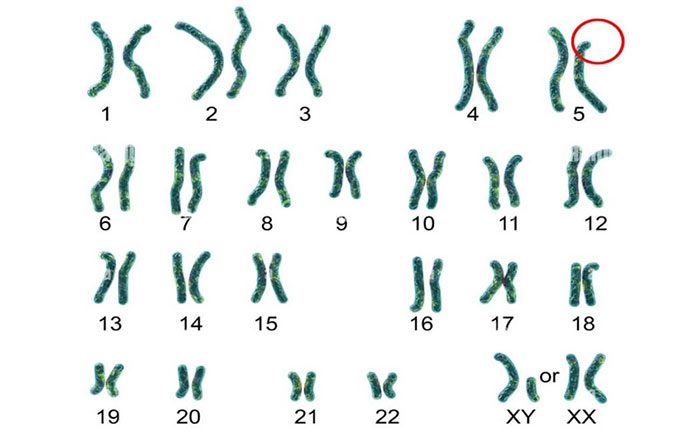Cry of the Cat Syndrome is a very rare condition. Children with this syndrome face significant challenges in communication, have poor motor skills, and experience limitations in intellectual development.
Let’s explore the causes, symptoms, and treatment options for this condition in the following article.
1. What Causes Cry of the Cat Syndrome?
Cry of the Cat Syndrome, known as Cri du chat, was first identified in 1963. This rare condition occurs in approximately 1 in every 15,000 to 50,000 newborns. The primary cause of this syndrome is the deletion of a portion of chromosome 5.

Cry of the Cat Syndrome is caused by chromosomal abnormalities.
The severity of the syndrome may vary depending on the length and location of the deleted segment of chromosome 5. For example, if a longer segment at a more critical location is deleted, those children are likely to experience more severe developmental delays compared to cases with shorter deletions.
About 10% of affected children have been confirmed to inherit the chromosomal abnormality from one of their parents. Typically, the deletion of chromosome 5 occurs due to an unusual random event during the formation of reproductive cells, which could originate from either the egg or sperm, or it may be an issue arising during the early development of the fetus. Many cases occur without any family history of the disorder.
2. What Symptoms are Associated with Cry of the Cat Syndrome?

Children have a cry similar to a cat’s meow.
Typically, the symptoms of Cry of the Cat Syndrome can be detected early, even during the newborn phase. These include:
- Crying like a cat: This is a common and easily recognizable symptom in the first weeks of a child’s life. Affected children often have a high-pitched, shrill, and piercing cry akin to that of a cat. However, this symptom tends to become less distinct as the child grows older.
- At birth, the child’s weight is very low, head circumference is small, and there may be growth deficiencies,…
- Various physical abnormalities such as a round face, strabismus (crossed eyes) or widely spaced eyes, deep-set eyelid folds, abnormal outer ear folds, a broad nasal bridge, low-set ears, a high palate, cleft lip, and small jaw,…

Children are underweight at birth.
- Due to hypotonia, children may have difficulties feeding, are prone to gastroesophageal reflux, and are at risk of pneumonia. Many children with the syndrome may not be able to feed themselves with a spoon until they are 3.5 years old.
- Scoliosis, congenital disabilities, or are at risk for ear infections and hearing loss.
- Difficulty performing actions that require coordination between mind and muscles, such as sitting up and walking,…
- Delayed learning and speech development.
- Some children may be hyperactive and exhibit self-harming behaviors.
- Additionally, children may present with other unusual characteristics such as webbed fingers, premature graying of hair, cataracts, myopia, inguinal hernias, respiratory infections, urinary issues, and intestinal infections,…
3. Diagnosis and Treatment Methods
In addition to clinical symptoms, doctors perform chromosomal analysis and fluorescence in situ hybridization (FISH) tests to identify the deletions on chromosome 5, enabling accurate diagnosis.
Depending on the severity of the condition, doctors will propose appropriate treatment methods. Furthermore, treatment often requires collaboration among various specialists, including pediatricians, cardiologists, neurologists, orthopedic surgeons, and physical therapists, to ensure comprehensive care for the affected child and achieve the best treatment outcomes.
Early detection and timely intervention are crucial factors in helping affected children improve their symptoms and develop optimally. Children require special education, physical therapy, language development training, vocational training, and more to ensure a better future.
If children suffer from certain deformities such as scoliosis, strabismus, cleft lip, or congenital heart defects, surgical intervention may be necessary to effectively treat these symptoms.
Typically, children with Cry of the Cat Syndrome can lead fulfilling lives, with some individuals living beyond the age of 50. Research has shown that early and appropriate education, combined with other therapeutic interventions, can help patients acquire skills comparable to those of children aged five or six.
4. Can Cry of the Cat Syndrome be Prevented?
Cry of the Cat Syndrome is caused by chromosomal abnormalities, and currently, there is no known prevention method. However, experts recommend that couples wishing to conceive take the following precautions to reduce the risk of having a child with this syndrome:
- Maintain a healthy lifestyle to ensure good health before pregnancy.
- Undergo pre-marital health check-ups and regular health screenings every six months: Regular health check-ups help couples identify any abnormalities early and treat them before pregnancy, thus reducing many potential risks for their future children.
- Avoid living and working in polluted environments with harmful substances. When working, ensure to wear protective gear as required.
- Ensure complete vaccination before and during pregnancy.
- Pregnant mothers should rest and eat a balanced diet, and regularly attend prenatal check-ups as scheduled by their healthcare provider.
If children exhibit any unusual symptoms, it is advisable to take them for an examination as soon as possible to facilitate early detection and timely, effective treatment.


















































